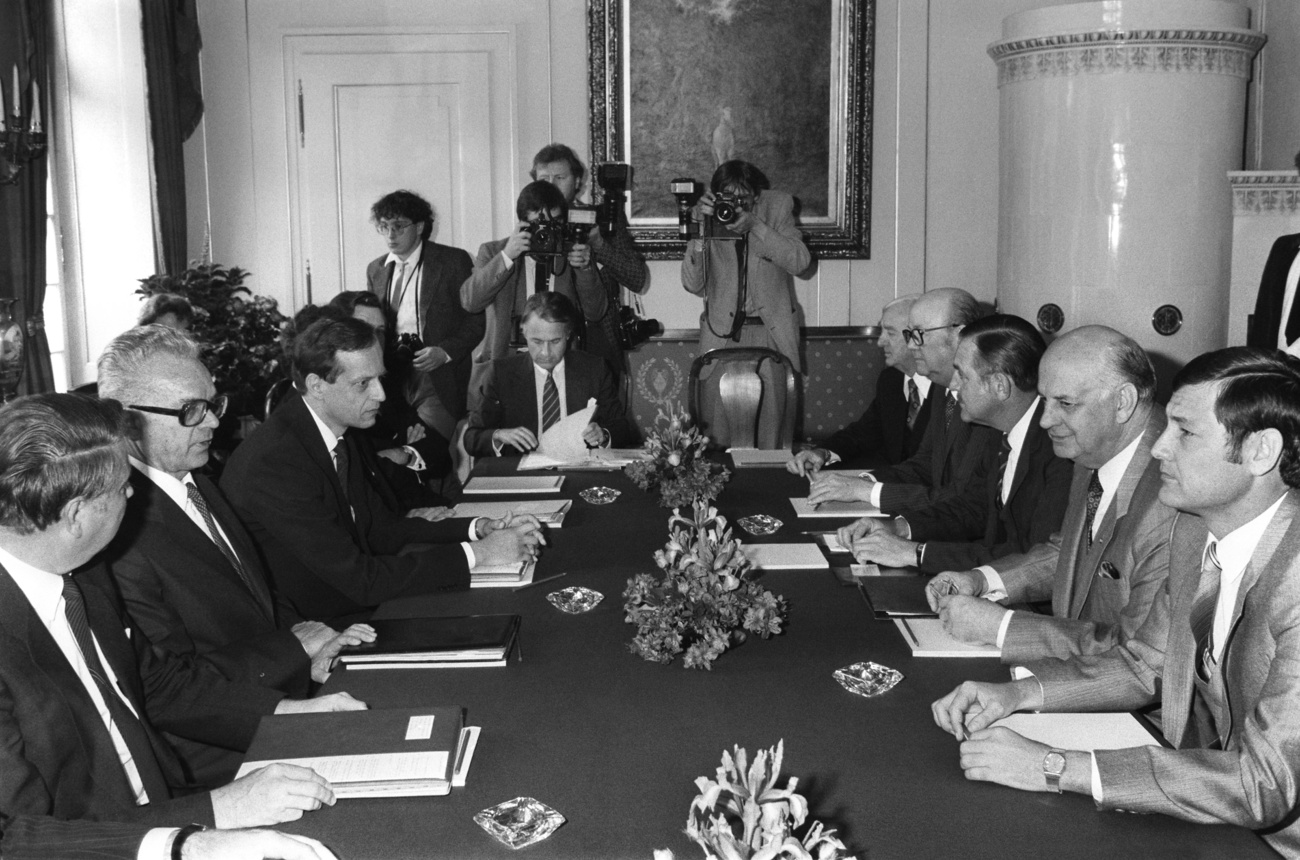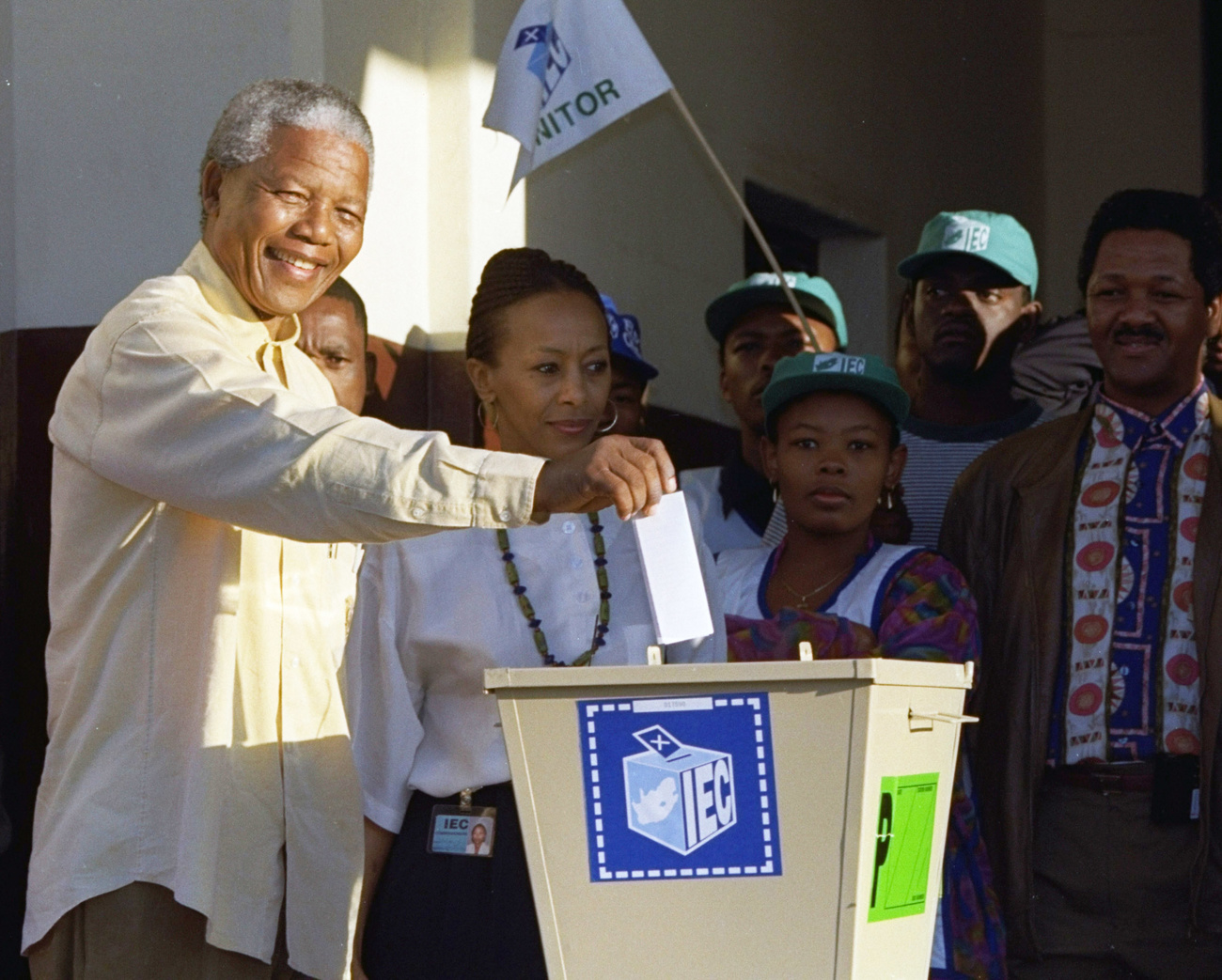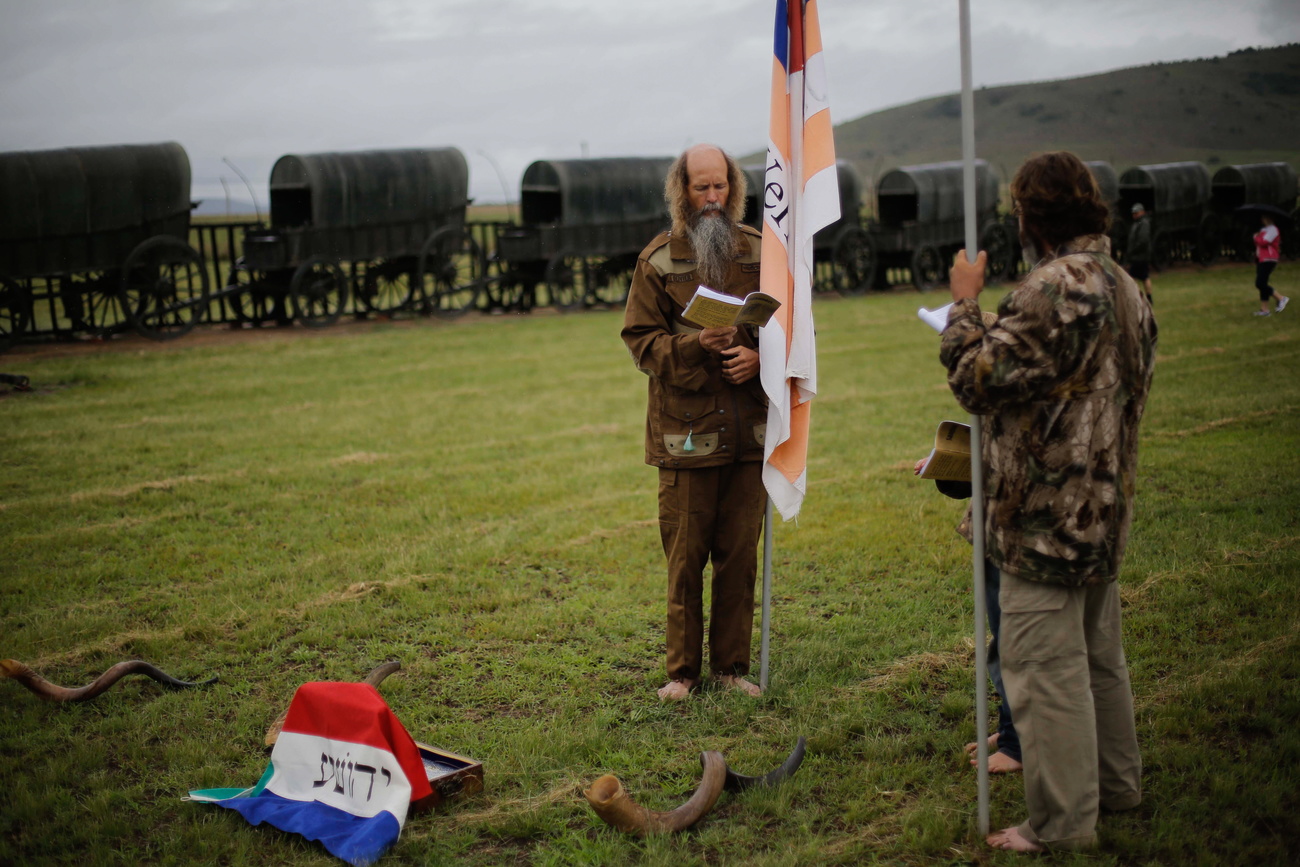Anti-apartheid protest at the AGM of the Swiss Banking Corporation (a predecessor of UBS), 1989.
Keystone
Before the first free elections were held in South Africa 30 years ago, Switzerland maintained close economic ties with the apartheid regime.
Switzerland once played a role in South Africa’s ambitions to become a nuclear power. The racist apartheid regime that ruled the country until the end of the Cold War developed six nuclear bombs – with Swiss support, a study revealed almost 20 years ago. Industrial firms in eastern Switzerland provided components for uranium enrichment and materials that enhanced the range of nuclear bombs.

Historian Peter Hug, pictured in 2005.
Keystone
“Swiss industry was also a pillar of support for the secret South African nuclear arms programme,” wrote Bern historian Peter Hug in his studyExternal link, Relations between Switzerland and South Africa, dubbed NRP 42+. The findings, published in 2005, concluded that Switzerland had prioritised trade over human rights.
Apartheid started before 1948
Racial discrimination was rife in the British Commonwealth state even before the apartheid regime came to power with laws that prohibited sexual relationships and mixed marriages between whites and non-whites.
The “Nasionale Party” of the Boers who originated from the Netherlands won the elections in 1948. Apartheid, which means “separateness” in Afrikaans, was instituted as law. Under the new regulations, non-white groups were forced to live in designated homelands and serve the country as cheap labour without any political rights. In 1973, the United Nations declared apartheid a crime against humanity.
In 1960, South African police opened fire on several thousand black demonstrators, leading to the deaths of 69 people. Following this massacre, the UN adopted a stricter stance against South Africa; the Security Council imposed an arms embargo against the country.

The aftermath of the Sharpeville massacre, 1960.
Keystone
Switzerland followed suit in 1963, when it officially banned arms exports to South Africa. But the ban never really took hold. Instead, the Swiss army forged ties with the South African army during the 1960s and even invited a South African military delegation to Switzerland. The delegation expressed a keen interest in psychological warfare tactics against domestic adversaries.
Nevertheless, Switzerland repeatedly condemned the apartheid system following the UN Human Rights Conference in 1968 and imposed legal measures, such as imposing a cap on investments in South Africa in 1974. However, these laws provided Swiss companies with significant leeway to navigate around them.
Swiss share of investments topped 10%
While the UN was increasingly trying to isolate South Africa, Swiss companies were doing business with the apartheid regime, right until the end of the 1980s. Between 1979 and 1990, over 10% of all foreign investments in South Africa were Swiss.
Consequently, Switzerland became more important for the leaders of the apartheid regime, which wanted to intensify economic ties with the Alpine country. Major Swiss businesses moved their production to South Africa. One of them was the Schmidheiny family business, which in the 1980s controlled a third of the South African cement market and dominated its Eternit (a brand of fibre cement) market.
Traditional Swiss firms like Nestlé, Roche, Sulzer and Brown Boveri also transferred parts of their production operations to South Africa. By 1988, approximately 17,000 South Africans were employed by Swiss companies.

Swiss president Leon Schlumpf (second on the left) and his South African counterpart Pieter Willem Botha (second on the right) in Bern, 1984.
Keystone
Lucrative gold trade
Yet trade between South Africa and Switzerland accounted for just over 1% of Swiss trade – not including the trade in gold.
Sandra Bott, who analysed economic relations between Switzerland and South Africa as part of the NRP42+ study, was surprised at the significant role gold trade played in Swiss-South African relations. By 1968, Swiss banks had replaced the United Kingdom as the global hub for the international gold trade. This included gold from South Africa. Working in a joint pool, major Swiss banks imported more than half of the gold mined in South Africa. Swiss banks had been active in South Africa’s diamond industry since the 1950s. At its peak in 1984, the Swiss banks’ business volume totalled CHF4 billion ($4.53 billion).

Nelson Mandela casting his vote in South Africa’s first free elections, 1994.
Keystone
As Bott discovered, Swiss authorities were also involved in concealing capital movements to the apartheid regime in 1968. “On behalf of the Swiss foreign ministry, the Swiss ambassador in Pretoria instructed the central bank to alter its records,” Bott said in 2010, “so that countries no longer appeared by name.” Thanks to this alteration, Switzerland was listed in the statistics of the South African central bank under “the rest of Europe”.
More

More
In South Africa, right-wing white populists do politics but not the elections
Federal Council blocks access to apartheid-era archives
The Swiss government caused a scandal of its own during the NRP42+ study by blocking access to official archive records that contained the names of Swiss companies that did business with South Africa. Denying access to files to researchers who had been mandated by parliament to do the study prompted public resentment. The government justified its decision by arguing that Swiss companies operating in South Africa were being threatened with class-action lawsuits in the United States.
In 2022, Green Party parliamentarian Léonore Porchet launched an initiative for a new NRP42+ study on Swiss relations with South Africa’s apartheid regime. In a statement, the government announced that access to the archives had been reinstated and were open to researchers again following a 2014 decision. However, the government did not consider additional funding necessary for this research initiative.

Green Party parliamentarian Léonore Porchet.
Keystone / Anthony Anex
The restriction on South African archives ended in 2014 after the last class-action suits linked to South Africa were rejected by a US court in 2013. The Swiss government also recommended rejecting Porchet’s initiative. The motion was withdrawn before parliament could decide on the issue.
Historian Georg Kreis, who chaired the NRP42+ project, asserts that embarking on a new investigation into Swiss-South African relations would only be feasible with both political commitment and adequate funding. He believes that access to the archives could facilitate “making up for past limitations”. But achieving this goal would only be possible with a political mandate to do exactly that.
Edited by David Eugster. Adapted from German by Billi Bierling/gw
When racial segregation became law in South Africa in 1950, the Swiss companies Ciba-Geigy (now Novartis), Roche, BBC (now ABB) and UBS opened branches on the Cape.
In 1956, the Swiss–South African Association, which acted as a chamber of commerce, was founded in Zurich.
In 1960, 69 black demonstrators were killed by police in Sharpeville. Following a nationwide strike, the African National Congress (ANC) was subsequently banned.
In 1963, the UN imposed an arms embargo on South Africa that Swiss companies managed to circumvent.
In 1964, ANC leader Nelson Mandela was sentenced to life imprisonment together with other activists.
In 1968, Swiss banks created a buying pool for gold mined in South Africa.
Until the late 1980s, Swiss banks had bought South African gold to the tune of at least CHF300 billion.
In 1974, the Swiss government implemented a cap on annual investments in South Africa at CHF250 million. The limit was increased to CHF300 million in 1980. However, Swiss firms regularly found ways to bypass this investment cap.
In 1976, around 600 people were killed throughout the country following the Soweto uprising.
In 1986, Switzerland supported South African NGOs fighting for the end of apartheid and the introduction of democracy.
In 1990, Pretoria lifted the ban on the ANC. On February 11, Nelson Mandela was released from prison. On June 8, he met former Swiss foreign minister René Felber during a visit to Switzerland.
In April 1994, the ANC won the elections in a landslide victory. Nelson Mandela became South Africa’s first black president.
This 2010 article was updated and re-edited in 2024 with new research and information.
